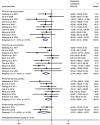Association Between Exposure to Per- and Polyfluoroalkyl Substances and Birth Outcomes: A Systematic Review and Meta-Analysis
- PMID: 35400049
- PMCID: PMC8988915
- DOI: 10.3389/fpubh.2022.855348
Association Between Exposure to Per- and Polyfluoroalkyl Substances and Birth Outcomes: A Systematic Review and Meta-Analysis
Abstract
Background: A large body of emerging evidence suggests that per- and polyfluoroalkyl substances (PFAS) affect birth outcomes in various pathways, but the evidence is inconsistent. Therefore, this study aimed to systematically review the epidemiological evidence on PFAS exposure and birth outcomes.
Methods: Three electronic databases were searched for epidemiological studies through February 13, 2021. We used random-effects meta-analysis for eight birth outcome indicators to calculate summary effect estimates for various exposure types. The risk of bias and the overall quality and level of evidence for each exposure-outcome pair were assessed.
Results: The initial search identified 58 potentially eligible studies, of which 46 were ultimately included. Many PFAS were found to have previously unrecognized statistically significant associations with birth outcomes. Specifically, birth weight (BW) was associated with PFAS, with effect sizes ranging from -181.209 g (95% confidence interval (CI) = -360.620 to -1.798) per 1 ng/ml increase in perfluoroheptanesulfonate (PFHpS) to -24.252 g (95% CI = -38.574 to -9.930) per 1 ln (ng/ml) increase in perfluorodecaoic acid (PFDA). Similar patterns were observed between other PFAS and birth outcomes: perfluorooctanoic acid (PFOA) and perfluorooctane sulfonate (PFOS) with birth length (BL) and ponderal index (PI), PFOS and perfluorododecanoic acid (PFDoDA) with head circumference (HC), PFHpS with gestational age (GA), and perfluorononanoic acid (PFNA) and PFHpS with preterm birth (PTB). Additionally, PFDA showed a statistically significant association with small for gestational age (SGA). The level of the combined evidence for each exposure-outcome pair was considered to be "moderate".
Conclusion: This study showed that PFAS exposure was significantly associated with increased risks of various adverse birth outcomes and that different birth outcome indicators had different degrees of sensitivity to PFAS. Further studies are needed to confirm our results by expanding the sample size, clarifying the effects of different types or doses of PFAS and the time of blood collection on birth outcomes, and fully considering the possible confounders.
Keywords: birth outcome; birth weight; meta-analysis; per- and polyfluoroalkyl substances; systematic review.
Copyright © 2022 Gui, Chen, Wu, Liu, Wang, Liang, Jiang, Li and Hu.
Conflict of interest statement
The authors declare that the research was conducted in the absence of any commercial or financial relationships that could be construed as a potential conflict of interest.
Figures







References
Publication types
MeSH terms
Substances
LinkOut - more resources
Full Text Sources
Research Materials
Miscellaneous

